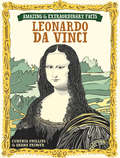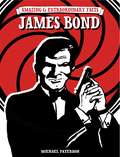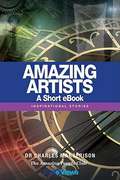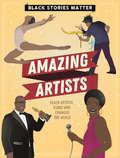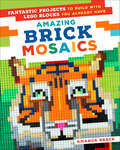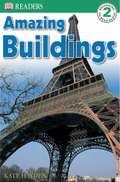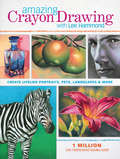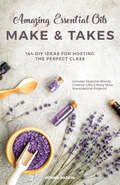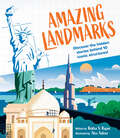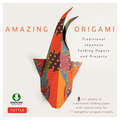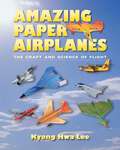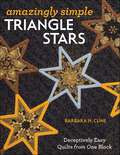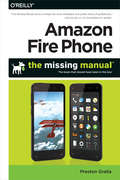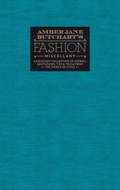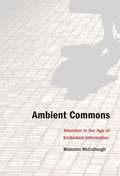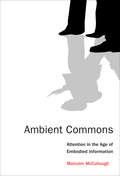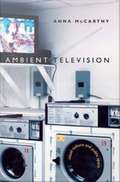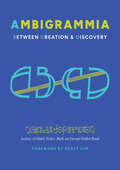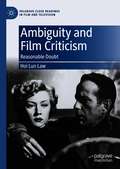- Table View
- List View
Amazing & Extraordinary Facts - Da Vinci (Amazing & Extraordinary)
by Cynthia Phillips Shana PriwerA unique collection of surprising revelations and quirky stories about one of the most amazing people ever to have lived. This engaging volume reveals Da Vinci's phenomenal accomplishments, including mathematical discoveries, investigating the secrets of the human body, inventing a robot and even his plans to divert the entire Arno River!
Amazing & Extraordinary Facts - James Bond
by Michael PatersonWhere did James Bond's creator, Ian Fleming, gain inspiration for his character? What was Ian Fleming's original name for his spy?Who wrote the James Bond theme?How did JFK influence the release of From Russia with Love?An essential companion for every Bond fan, this book will unearth a plethora of surprising and intriguing facts about the much-loved fictional spy, and the books and films he has starred in. Brimming with strange and amusing stories about the Bond actors, from Sean Connery to Daniel Craig, behind-the-scenes tidbits from the film sets, and amazing facts about Ian Fleming's original novel, the brief, accessible and entertaining pieces make this the perfect book to dip in to.
Amazing & Extraordinary Facts: James Bond
by Michael PatersonWhere did James Bond's creator, Ian Fleming, gain inspiration for his character? What was Ian Fleming's original name for his spy? Who wrote theJames Bondtheme? How did JFK influence the release ofFrom Russia with Love? An essential companion for every Bond fan, this book will unearth a plethora of surprising and intriguing facts about the much-loved fictional spy, and the books and films he has starred in. Brimming with strange and amusing stories about the Bond actors, from Sean Connery to Daniel Craig, behind-the-scenes tidbits from the film sets, and amazing facts about Ian Fleming's original novel, the brief, accessible and entertaining pieces make this the perfect book to dip in to.
Amazing Artists - A Short eBook
by Charles MargerisonIn this unique collection of audio stories about some of the world's most amazing artists, meet Michelangelo in 1485, when he was born in a small village in Tuscany. You'll travel with him to Rome at the age of 21 and understand how he came to complete some of the world's most influential pieces of art, including the Statue of David and the awe-inspiring ceiling of the Sistine Chapel, which took him four years to complete. Meet also another Italian - the fascinating Rosalba Carriera, who from lowly beginnings went on to become an influential Rococo painter. Samuel Morse is of course known for developing Morse code however, few people realize that he was actually an artist. He painted influential figures including President John Adams and was the artist of pieces including Dying Hercules. Finally you'll get a unique insight to the amazing life of Leonardo da Vinci, who many believe to be the most diversely talented man to have lived. Understand his major works, including The Last Supper and Virgin of the Rocks within the context of his real life. Each story comes to life through BioViews®. These are short biographical narratives, similar to interviews. They provide an easy way of learning about amazing people who made major contributions and changed our world.
Amazing Artists (Black Stories Matter)
by J.P. MillerA celebration of the lives and achievements of inspirational black people through history who made a differenceAmazing Artists explores the contribution of black artists to world culture, from painters such as Jean-Michel Basquiat to writers like Malorie Blackman and inspirational musicians such as Stevie Wonder. Along the way, they have smashed down barriers and defeated prejudices with their sheer talent and resilience.Black Stories Matter is a powerful illustrated collection of stories of inspiring black personalities through history. Perfect for readers aged 8 and above.Contents:Main biographiesJean-Michel BasquiatToni MorrisonSteve McQueen Nina SimoneMalorie BlackmanSidney PoitierBeyonce and Jay-ZChris OfiliMisty CopelandStevie WonderMini biographiesStormzyChimamanda Ngozi AdichieIdris ElbaNikki GiovanniLangston HughesLupita Nyong'oEdmonia LewisEmily Kame Kngwarreye
Amazing Brick Artists (Fountas & Pinnell LLI Gold #Level R)
by Jordan Brown<p>Can Art Be Made Out of Anything? <p>When you think of visiting an art museum, you probably think of oil paintings and marble sculptures. But there's plenty of art that's made from more common materials, and you can see them at a modern art museum. Some artists today make art using things like rubber tires, masking tape, recycled computer parts, and even bubble gum! <p>An artist's medium is the material he or she uses to create a work. Any medium can work in the imagination of an artist. Before you throw out an old pen, cereal box, or candy wrapper, think: Could I make art with this? <p>Text Elements: <p> <li>Genre: Narrative Nonfiction <li>Text Structures: Main: Chronological Sequence Embedded: Compare/Contrast, Temporal Sequence, Description <li>Text Features: table of contents, headings, photos, captions, glossary</li> </p>
Amazing Brick Mosaics: Fantastic Projects to Build with Lego Blocks You Already Have
by Amanda BrackBuild awesome paintings brick by brick!Every LEGO-loving kid has at least one huge bin of bricks – the sets are built, dismantled, and typically never built again – and this book gives them dozens of ways to reuse them in fun projects that range from easy to challenging. Featuring a simple yet elegant mosaic technique, step-by-step instructions, and full-color photographs for making 25 cool two-dimensional pictures, Amazing Brick Mosaics offers unique projects that will delight any LEGO enthusiast.
Amazing Buildings
by Kate HaydenHave you ever heard of a hotel made of snow? How would you put a building into space? And who washes the windows on the tallest skyscrapers in the world? Learn about the world's most famous and unique structures, from the ancient Coliseum to eco-friendly stadiums, in the Level 2 DK Reader Amazing Buildings.
Amazing Cakes: Recipes for the World's Most Unusual, Creative, and Customizable Cakes
by Instructables. Com Sarah JamesRubik’s cubes, fire-breathing dragons, and jack-o-lanterns.Pirate ships, pianos, and Star Wars figurines. With Instructables.com’s Amazing Cakes, you’ll be able to make cakes shaped like animals, mythical creatures, and vehicles. They may light up, breathe fire, or blow bubbles or smoke. They may be 3D or they may be animated, seeming to move of their own free will. Whether they’re cute and cuddly (like a penguin) or sticky and gross (like a human brain!), these cakes have two things in common: They’re (mostly) edible and they’re amazing! Instructables.com authors walk you through each step of the process as you cut plywood for cake bases, hardwire figurines for automation, and mix nontoxic chemicals for explosions and eruptions. The photos accompanying the step-by-step directions provide additional information about the processes and enable you to compare your final products with the originals created by the expert cake artists of Instructables.com. In addition to the cakes mentioned above, you’ll also learn how to make cakes shaped like: Yoda Helicopters 3D dinosaurs Moving tanks Pi signs (p) Bass fish Zombie heads Swimming pools Ladybugs Evil clowns And more!
Amazing Crayon Drawing With Lee Hammond: Create Lifelike Portraits, Pets, Landscapes and More
by Lee HammondYoung at art! Combine the familiar charm of crayons with "grown-up" art techniques for surprisingly realistic results Your old childhood coloring friends are all grown up! In this unique book, best-selling artist Lee Hammond proves that crayons are not just for kids anymore but can hold their own as a "serious" (if unexpected) art medium. Use Hammond's easy methods to create striking drawings that feature brilliant color and incredibly lifelike texture. 29 step-by-step demonstrations cover a wide range of subjects--still life, landscapes, animals and people Simple blending, layering and burnishing techniques translate into remarkably realistic drawings Hammond's graphing and "puzzle piece" theories help you draw any subject with true-to-life results Features great tricks you can pass along to other crayon lovers in your life, regardless of age You simply won't believe what you can accomplish with this familiar and affordable medium. Rediscover the creative thrill of opening the "big box," and infuse your art with a fresh sense of play.
Amazing Essential Oils Make and Takes: 144 DIY Ideas for Hosting the Perfect Class
by Donna RaskinWow your guests with these wonderfully scentsational recipesPacked with 144 seasonal blends, creative gifts and inspiring projects, Amazing Essential Oils Make & Takes will guarantee your guests leave every oils class with something fun, unique and special. These clever solutions are perfect for around the house, medicine, family, pets, bath, beauty and more, including: • Lavender Kitchen Degreaser• Vanilla Sugar Car Diffuser• Lemon & Basil Room Freshener• Rose & Tea Tree Brightener Mask• Gingermint Upset Stomach Soother• Rosemary & Lavender Eyelash Serum• Valerian Root Pet Shampoo• Blue Tansy Bath Bomb• White Fir Beard Softener
Amazing Facts About Baby Animals: An Illustrated Compendium
by Maja SäfströmA whimsically illustrated collection of fascinating, surprising, and funny facts about baby animals and their parents, from the author of The Illustrated Compendium of Amazing Animal Facts.Who doesn't love baby animals? Amazing Facts About Baby Animals is an adorable celebration of all kinds of fuzzy, fluffy, scaly, and feathery animal babies and their parents. This charming collection by beloved Swedish artist Maja Säfström is full of interesting, weird, and funny facts about animals before they are born (elephants are pregnant for 22 months!), when they are born (whales are born tail-first so they don't drown!), and life as babies (parrots give their offspring names! Baby macaques have snowball fights!). Perfect for art- and nature-loving kids and adults, this sweet book makes a wonderful gift and conversation starter for the whole family.
Amazing Landmarks: Discover the hidden stories behind 10 iconic structures!
by Rekha S. RajanCould you build the world's most iconic landmarks?Could you design the Golden Gate Bridge? Could you construct the Eiffel Tower? Could you decorate the Burj Khalifa? Could you make a budget, draw up the plans, and handle every problem that arises to create something that withstands the test of time?This accessible nonfiction compendium explores the creation of 10 global landmarks, from the first spark of an idea to the final layer of paint. Acclaimed educator Rekha Rajan encourages readers to see themselves as the engineers, builders, architects, and more through interactive stories and a unique structure.Graphic artist Alex Asfour's gorgeous art works seamlessly with engaging photographs to create a standout nonfiction title that will appeal to both kids and educators.Ideal for any grade-schooler with an interest in STEAM!
Amazing Origami
by Tuttle EditorsOrigami paper with stunning Japanese traditional prints and fun and simple folding instructions!Amazing Origami is designed for origami paper folders of all ages and all skill levels-from novices up to more experienced folders. It provides everything you need to create exciting and original origami art. The gorgeous folding papers feature delicate patterns with gold detailing, recalling the one-of-a-kind traditional designs used in the Japanese kimono fabrics from a bygone era.This origami ebook contains: A full-colored 64-page booklet Clear step-by-step instruction and diagrams 17 fun-to-do projects Downloadable folding sheetsOne of the wonderful aspects of origami is it's simplicity. The paper folder needs nothing more than something to fold-no glue, no tape, no string or wire-just a piece of paper! Though the materials are simple, origami exemplifies the ability of the human mind to solve problems and create beautiful harmony. Origami is relaxing and peaceful, but it is also fun and exciting to discover new ways to fold paper. With Amazing Origami's simple instructions, origami beginners will be able to get started immediately. With the beautiful, Japanese origami paper, experienced paper folders can create unique origami art.Origami projects include: Luna Moth Tortoise Carp Leaf Peacock Butterfly Koi Chinese Pinwheel And many more...
Amazing Paper Airplanes: The Craft and Science of Flight
by Kyong Hwa LeeIn this book Kyong Hwa Lee combines the art of origami and the science of flight to create unique paper airplane designs for aviation enthusiasts of all ages. Featuring thirty-two designs, Amazing Paper Airplanes showcases models resembling real-world aircraft, including the F-22 fighter jet, a P-51 World War II plane, the Convair F-102 Delta Dagger—the first supersonic delta-wing interceptor airplane of the US Air Force—and more. For these models, Lee provides information along with an image of the real plane to encourage interest in aerospace technology. Every design has been flight-tested and presents complete step-by-step folding instructions. In addition to showing basic and advanced folding techniques and providing templates for each plane, the author explains the theory behind flight and offers tips to fine-tune paper airplanes for optimal flying.
Amazingly Simple Triangle Stars: Deceptively Easy Quilts from One Block
by Barbara H. Cline9 dynamic quilts from 1 easy-to-sew block Turn a single block into eight distinctive quilts—the magic is in the fabric! Best-selling author and well-known teacher Barbara H. Cline takes an easy-to-sew triangle block and then shows countless intricate designs for you to experiment with color and value. Stunning triangle-star quilts are perfect for the adventurous beginner looking to try something new or the intermediate quilter who wants to put her skills to use in a creative way. Design your own quilt top using a provided line drawing that you can color in and then bring to life with creative fabric selection! • From best-selling author and well-known teacher Barbara H. Cline • Change the fabric placement for unique designs • Color in a provided line drawing to design your own triangle-star quilts
Amazon Fire Phone: The Missing Manual
by Preston GrallaUnleash the powers of the Amazon Fire phone with help from technology guru Preston Gralla. Through clear instructions and savvy advice, this fast-paced, engaging guide shows you how to make the most of Fire phone’s innovative features—including Firefly, Dynamic Perspective, one-handed gestures, and integration with Amazon Prime.The important stuff you need to know:Gain control with Dynamic Perspective. Tilt your phone to scroll, move your head to play games, and explore maps in 3D.Take pictures further. Capture high-res, panoramic, and moving (lenticular) photos. Shoot HD video, too.Shop with ease. Use Firefly to identify music, videos, and other items, and go straight to the product’s Amazon page.Get the apps you want. Load up on games and apps for productivity, health and fitness, and social networking from Amazon’s Appstore.Solve problems right away. Get live tech support from Amazon via video chat with the Mayday help feature.Carry the Cloud in your hand. Access Prime Instant Video, your Kindle library, and your uploaded photos and videos.
Amber Jane Butchart's Fashion Miscellany: An Elegant Collection Of Stories, Quotations, Tips And Trivia From The World Of Style
by Amber Jane ButchartStyles come and go, but fashion has an enduring appeal, a rich history, and everyday practical relevance for millions. Following the successful formula of PRING'S PHOTOGRAPHER'S MISCELLANY (Ilex, 2011) (and many others), Amber Jane Butchart's collection is the perfect gift read and full of little known facts and stories from the world of fashion and style. Classically typeset, modishly illustrated, and with its own garment label on the front cover, the book is not just a fascinating read, it's a stylish object in its own right. Launched to coincide with New York Fashion Week 2014, this beautifully-packaged book offers a host of new perspectives on a classic subject. Professional fashion expert Amber Jane Butchart casts a quizzical eye over fashion's oddities, revealing the histories of such garments as the Adelaide boot, the origins of many technical terms and a host of entertaining quotes and aphorisms from the field's most colorful names. New line illustrations from Penelope Beech complete the book, making it a feast for the eyes as well as a treat for the stylish soul.
Amber Jane Butchart's Fashion Miscellany: An Elegant Collection of Stories, Quotations, Tips & Trivia from the World of Style
by Amber ButchartStyles come and and go, but fashion has an enduring appeal, a rich history, and an everyday practical relevance for millions.Launched to coincide with London Fashion Week 2014, this book offers a host of new perspectives on a classic subject. Professional fashion expert Amber Jane Butchart casts a quizzical eye over fashion's oddities, revealing the histories of such garments as the Adelaide boot, the origins of many technical terms and a host of entertaining quotes and aphorisms from the field's most colourful names.Specially-commissioned line illustrations from Penelope Beech complete the book, making it a feast for the eyes as well as treat for the stylish soul.
Ambient Commons
by Malcolm McculloughThe world is filling with ever more kinds of media, in ever more contexts andformats. Glowing rectangles have become part of the scene; screens, large and small, appeareverywhere. Physical locations are increasingly tagged and digitally augmented. Sensors, processors,and memory are not found only in chic smart phones but also built into everyday objects. Amid thisflood, your attention practices matter more than ever. You might not be able to tune this world out. So it is worth remembering that underneath all these augmentations and data flows, fixed formspersist, and that to notice them can improve other sensibilities. In AmbientCommons, Malcolm McCullough explores the workings of attention though a rediscovery ofsurroundings. Not all that informs has been written and sent; not all attention involves deliberatethought. The intrinsic structure of space -- the layout of a studio, for example, or a plaza --becomes part of any mental engagement with it. McCullough describes what he calls the Ambient: anincreasing tendency to perceive information superabundance whole, where individual signals matterless and at least some mediation assumes inhabitable form. He explores how the fixed forms ofarchitecture and the city play a cognitive role in the flow of ambient information. As apersistently inhabited world, can the Ambient be understood as a shared cultural resource, to besocially curated, voluntarily limited, and self-governed as if a commons? AmbientCommons invites you to look past current obsessions with smart phones to rethink attentionitself, to care for more situated, often inescapable forms of information.
Ambient Commons: Attention in the Age of Embodied Information (The\mit Press Ser.)
by Malcolm McCulloughOn rediscovering surroundings when information goes everywhere.The world is filling with ever more kinds of media, in ever more contexts and formats. Glowing rectangles have become part of the scene; screens, large and small, appear everywhere. Physical locations are increasingly tagged and digitally augmented. Amid this flood, your attention practices matter more than ever. You might not be able to tune this world out. So it is worth remembering that underneath all these augmentations and data flows, fixed forms persist, and that to notice them can improve other sensibilities. In Ambient Commons, Malcolm McCullough explores the workings of attention through a rediscovery of surroundings.McCullough describes what he calls the Ambient: an increasing tendency to perceive information superabundance whole, where individual signals matter less and at least some mediation assumes inhabitable form. He explores how the fixed forms of architecture and the city play a cognitive role in the flow of ambient information. As a persistently inhabited world, can the Ambient be understood as a shared cultural resource, to be socially curated, voluntarily limited, and self-governed as if a commons? Ambient Commons invites you to look past current obsessions with smart phones to rethink attention itself, to care for more situated, often inescapable forms of information.
Ambient Media: Japanese Atmospheres of Self
by Paul RoquetAmbient Media examines music, video art, film, and literature as tools of atmospheric design in contemporary Japan, and what it means to use media as a resource for personal mood regulation. Paul Roquet traces the emergence of ambient styles from the environmental music and Erik Satie boom of the 1960s and 1970s to the more recent therapeutic emphasis on healing and relaxation.Focusing on how an atmosphere works to reshape those dwelling within it, Roquet shows how ambient aesthetics can provide affordances for reflective drift, rhythmic attunement, embodied security, and urban coexistence. Musicians, video artists, filmmakers, and novelists in Japan have expanded on Brian Eno&’s notion of the ambient as a style generating &“calm, and a space to think,&” exploring what it means to cultivate an ambivalent tranquility set against the uncertain horizons of an ever-shifting social landscape. Offering a new way of understanding the emphasis on &“reading the air&” in Japanese culture, Ambient Media documents both the adaptive and the alarming sides of the increasing deployment of mediated moods.Arguing against critiques of mood regulation that see it primarily as a form of social pacification, Roquet makes a case for understanding ambient media as a neoliberal response to older modes of collective attunement—one that enables the indirect shaping of social behavior while also allowing individuals to feel like they are the ones ultimately in control.
Ambient Television: Visual Culture and Public Space
by Anna MccarthyAlthough we tend to think of television primarily as a household fixture, TV monitors outside the home are widespread: in bars, laundromats, and stores; conveying flight arrival and departure times in airports; uniting crowds at sports events and allaying boredom in waiting rooms; and helping to pass the time in workplaces of all kinds. In Ambient Television Anna McCarthy explores the significance of this pervasive phenomenon, tracing the forms of conflict, commerce, and community that television generates outside the home. Discussing the roles television has played in different institutions from 1945 to the present day, McCarthy draws on a wide array of sources. These include retail merchandising literature, TV industry trade journals, and journalistic discussions of public viewing, as well as the work of cultural geographers, architectural theorists, media scholars, and anthropologists. She also uses photography as a research tool, documenting the uses and meanings of television sets in the built environment, and focuses on such locations as the tavern and the department store to show how television is used to support very different ideas about gender, class, and consumption. Turning to contemporary examples, McCarthy discusses practices such as Turner Private Networks' efforts to transform waiting room populations into advertising audiences and the use of point-of-sale video that influences brand visibility and consumer behavior. Finally, she inquires into the activist potential of out-of-home television through a discussion of the video practices of two contemporary artists in everyday public settings. Scholars and students of cultural, visual, urban, American, film, and television studies will be interested in this thought-provoking, interdisciplinary book.
Ambigrammia: Between Creation and Discovery
by Douglas HofstadterOn the history and creation of ambigrams, by a pioneer of the practice &“Spellbinding and truly one-of-a-kind. . . . This is an absolute delight.&”—Publishers Weekly (starred review) In the 1960s and 1970s, a trio of imaginative individuals independently discovered that ordinary words and phrases could be given double readings by playfully distorting the letters composing them. These doubly readable words and phrases, if designed by an artistic eye and hand, could possess great visual beauty. Douglas Hofstadter named such calligraphic creations &“ambigrams,&” and over the decades he has designed thousands of them, as have his friends Scott Kim and John Langdon, the other main pioneers of the subtle art form he calls ambigrammia. ABCD (Hofstadter&’s informal title for this book) offers a sampler of hundreds of Hofstadter&’s ambigrams, along with a few dozen by Kim, Langdon, and others. With deep links to cognitive science, ABCD exhibits ambigrams of many types and shows how ambigrammia can be extended in surprising directions. All along the way, Hofstadter discusses creativity and its alter ego, &“discoverativity,&” revealing how the &“pocket sized creativity puzzles&” that constitute the art form are pervaded by these complementary qualities. ABCD is also notably autobiographical: Hofstadter vividly recounts how his life has been intimately intertwined with the creation/discovery of ambigrams in many countries and in many languages.
Ambiguity and Film Criticism: Reasonable Doubt (Palgrave Close Readings in Film and Television)
by Hoi Lun LawThis book defends an account of ambiguity which illuminates the aesthetic possibilities of film and the nature of film criticism. Ambiguity typically describes the condition of multiple meanings. But we can find multiple meanings in what appears unambiguous to us. So, what makes ambiguity ambiguous? This study argues that a sense of uncertainty is vital to the concept. Ambiguity is what presses us to inquire into our puzzlement over a movie, to persistently ask “why is it as it is?” Notably, this account of the concept is also an account of its criticism. It recognises that a satisfying assessment of what is ambiguous involves both our reason and doubt; that is, reason and doubt can work together in our practice of reading. This book, then, considers ambiguity as a form of reasonable doubt, one that invites us to reflect on our critical efforts, rethinking the operation of film criticism.
